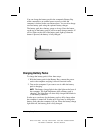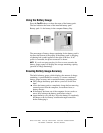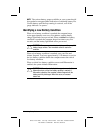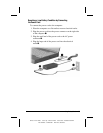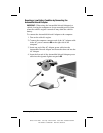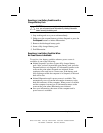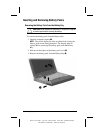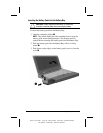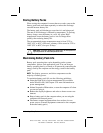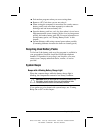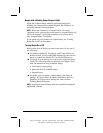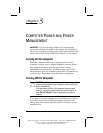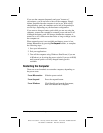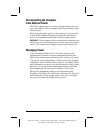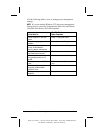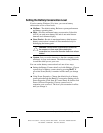
4-10 Using Battery Packs
Writer: Lorise Fazio Saved by: J Abercrombie Saved date: 12/08/98 4:03 PM
Part Number: 310296-002 File name: Ch04.doc
Storing Battery Packs
When storing the computer for more than two weeks, remove the
battery packs and store them separately to reduce the discharge
rate and increase battery life.
The battery pack self-discharges even when it is not being used.
The rate of self-discharge is affected by temperature. To prolong
battery charge, store the battery in a cool, dry place. High
temperatures cause the battery pack to lose its charge more
quickly, thus reducing battery life.
The recommended storage temperature range is from 32
q
F to
104
q
F (0
q
C to 40
q
C). However, a battery can be stored at 32
q
F to
140
q
F (0
q
C to 60
q
C) for up to 30 days.
CAUTION:
To prevent damage to a battery pack, do not expose it to
high temperatures for extended periods of time.
Maximizing Battery Pack Life
Battery pack operating time varies depending on the system
components, options, and applications used. You can increase
battery operating time by as much as 50 percent by controlling the
energy used by the computer and the energy stored in the battery
pack.
NOTE:
T
he display, processor, and drive components use the
majority of battery power.
To maximize battery pack life, use the following guidelines:
■
Select the High level of power management (not available
under Windows 98). See Chapter 5 for more information on
power management.
■
Initiate Suspend or Hibernation, or turn the computer off when
you are not using it.
■
Reduce the display brightness and select a shorter screen save
timeout.
■
Keep a battery pack in the computer when you are using the
computer with external power.
■
Disconnect external equipment that does not have its own
power source. (External equipment connected to the computer
drains the battery pack.)



